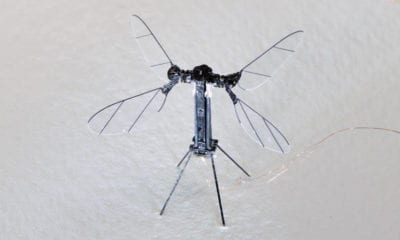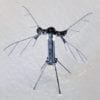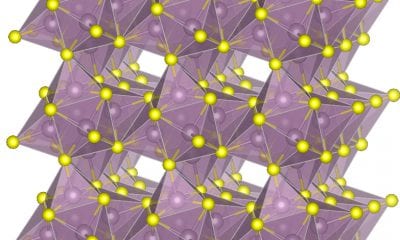Albatross Inspired Drones to Survey the Oceans
A team of mechanical & aerospace engineers looking to enhance drone design realised that large seabirds, such as albatross, have wings which are black on top and white beneath.
The albatross is one of the planet’s largest birds, with a wingspan of around 11 feet, the longest wingspan of any living bird species. They can fly hundreds of miles in 1 day, while exerting little effort. Some individual albatrosses are known to circumnavigate the Southern Ocean three times (covering more than 120,000 km or 75,000 miles) in one year!
Two separate groups of researchers found two different reasons for this particular species’ flight ability.
One piece of research out of MIT, “Optimal dynamic soaring consists of successive shallow arcs“, and published in the Journal of the Royal Society Interface, describes the albatross as a flying sailboat. According to the paper, the bird flies greatest in the crosswind and when making shallow arcs.
Albatross rely upon gliding and soaring flight, to fly long distances. These manners of flight are unpowered — instead so that they can ride the breeze of flapping to remain aloft, their wings are merely extended by the birds away from their body. Similar to aircraft, soaring birds rely upon lift and speed: lift is produced by the difference in air pressure flowing across the wing’s upper and lower surfaces, and gravity causes rate as the birds fall towards Earth. Collectively, speed and raise keep soaring birds airborne using a minimal expenditure of energy.
The MIT researchers developed a new model to simulate dynamic soaring, and have used it to identify the optimal flight pattern that an albatross should take in order to harvest the most wind and energy. They found that as an albatross banks or turns to dive down and soar up, it should do so in shallow arcs, keeping almost to a straight, forward trajectory.
The engineering potentialities of dynamic soaring are tantalizing: a robotic albatross could survey the oceans (or ride the wind shear of jet streams), and collect oceanic and atmospheric data, travelling at over 40 knots with a virtually infinite range.
The new model, they say, will be useful in gauging how albatross flight patterns may change as wind patterns shift with changing climate. It also may inform the design of wind-propelled drones and gliders which, if programmed with energy-efficient trajectories for given wind conditions, could be used to perform long-duration, long-range monitoring missions in remote regions of the world.
“The wandering albatross lives in the Southern Ocean, which is not very well-known. It’s very hard to get there, and there is a lot of wind and waves,” says Gabriel Bousquet, a graduate student in MIT’s Department of Mechanical Engineering. “The region is extremely important for understanding the dynamics of climate change. With robots that can use the wind, you could monitor in real-time and get much denser data than we can now. This is an important step forward to actually write algorithms for robots to be able to use the wind.”
Lots of other large migrating birds, and the albatross, have black on the very top of their wings. Another study, published in the Journal of Thermal Biology in March, analyzed the impact.
Professor Abdelkefi along with his collaborators at New Mexico State University, thought these birds might have some interesting lessons to educate them about making flight much more energetically efficient because albatross operate so close to the structural limits for wing span and wing loading. Whilst designing their studies, the team couldn’t help but notice that albatross wings’ color pattern has been repeated across a variety of seabirds.
The researchers concluded that this color scheme is important to a lifestyle because it is shown by so many unrelated species of birds that soar for long distances — but is this color pattern?
Ornithologists thought this colour pattern acted as camouflage; decreasing the odds that the birds’ prey might put them as they soar over the ocean’s surface, and diminishing the possibility that predators could spot these birds on their nests. But Professor Abdelkefi and his staff guessed another explanation could be at work so that they investigated.
“The question was: does this coloration have any particular effect on the flight endurance? Therefore, we began investigating the color effects on the flight aerodynamics,” Professor Abdelkefi explained.
In their analysis, his group and Professor Abdelkefi examined sunlight and wing surface color influence each other. They found that the black upper wing surface absorbs sun quite efficiently — so economically, in reality, that the darkened upper wing surface could become as much as 10° Celsius warmer than the light underside. Air pressure is lowered by this temperature difference on the side of this wing, which generates further elevator and reduces drag, according to the researchers. This serves to make soaring energetically for all these seabirds, especially over extended distances.
“The outcomes showed that birds using darker colors are more efficient (constant lift to drag ratio and drag reduction) and have better endurance,” Professor Abdelkefi clarified in email.
“Simulations on unmanned air vehicles show that these dark colors can decrease their drag,” Professor Abdelkefi said. “These bio-inspirations are more acceptable for drones [than aircraft], since they’ve closer dimensions to the migrating birds.”
Have Professor Abdelkefi and his team quantified the effects of sun on other wing color patterns?
“We are attempting to compare the skin drag created using white-white, white-black, black-white, and black-black so as to spot the very best arrangement of colors from aerodynamic and sustainable points of view,” Professor Abdelkefi stated, adding that this particular research is already in progress.
We’re still exploring whether black-black or black-white is better, attempting to investigate all of the intervening parameters,” Professor Abdelkefi explained.
Scientists discovered a temperature difference of about 10 degrees Celsius between dark and light colored top wings. That extra heat reduces the drag on the wings, according to the paper, leading to the animal’s capacity to fly such long distances.
The research could have impact on new drone technology.
References:
http://rsif.royalsocietypublishing.org/content/14/135/20170496#sec-2
https://www.ncbi.nlm.nih.gov/pubmed/28477907
How useful was this post?
Click on a star to rate it!
Average rating 0 / 5. Vote count: 0
No votes so far! Be the first to rate this post.
We are sorry that this post was not useful for you!
Let us improve this post!
Tell us how we can improve this post?


























